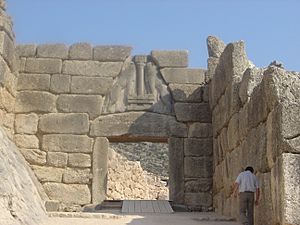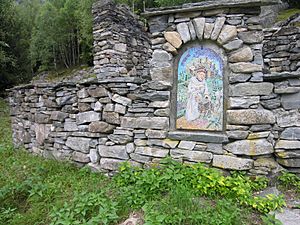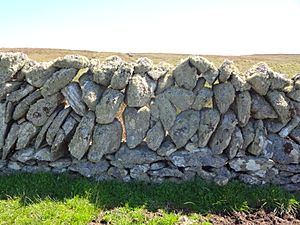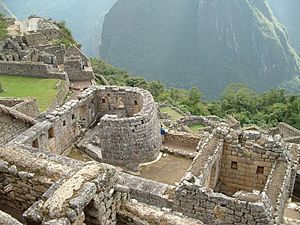Dry stone wall facts for kids
Dry stone, sometimes called drystack or, in Scotland, drystane, is a special way of building things using only stones. No mortar (which is like glue for stones) is used to hold them together. These structures are strong and stable because the stones are carefully chosen and fitted together like a puzzle. They interlock, meaning they hold onto each other tightly.
Dry stone building is most famous for making stone walls. These walls have been used for a long time to mark the edges of fields or churchyards. They also help hold back soil on hillsides, creating flat areas called terraces. But dry stone can also be used to build sculptures, houses, bridges, and other cool structures!
Contents
How Old Are Dry Stone Structures?

People have been building with dry stone for a very long time! Some dry stone walls in places like northwest Europe are super old, dating back to the Stone Age. For example, some walls in Ireland, which are now covered by peat (a type of soil), have been found to be about 5,800 years old!
The ancient Mycenae civilization in Greece built huge, strong walls using dry stone around 1350 BC. These are sometimes called "cyclopean" walls because they look like giants built them! Later, the Maya people in Belize also used dry stone to build parts of their cities in the 700s and 800s AD.
Where Can You Find Dry Stone Walls?
The names for dry stone structures can change depending on where you are. In Scotland, for example, they are often called "dykes."
You can find lots of dry stone walls in hilly parts of Britain and Ireland, especially where there are many natural rocks. The west of Ireland, like Connemara, has thousands of miles of these walls, many of them hundreds of years old. They are also common around the Mediterranean, often used to create terraces for farming.
In the United States, dry stone walls are common in places with rocky soil, like New England and Kentucky. Here, they are often called rock fences or stone fences. This building style was brought to America by immigrants from England and Scotland. You can also find similar walls in Australia and New Zealand.
The ancient city of Great Zimbabwe in Africa is another amazing example. Built between the 11th and 15th centuries, its huge stone walls were made using dry stone techniques. This city was once home to up to 18,000 people!
In Peru, the Inca people were masters of dry stone building. In places like Machu Picchu, they built incredible walls where the stones fit together so perfectly that you can't even slip a knife blade between them! These walls have lasted for centuries, even in earthquake-prone areas, because they are flexible.
How Are Dry Stone Walls Built?

Building a dry stone wall takes a lot of skill! There are different ways to build them, depending on the type and amount of stones available. Many old walls were made from stones cleared from fields, but today, stones are usually taken from quarries.
One common type is called a "double wall." This means two rows of stones are laid out. The biggest, flattest stones usually go at the bottom, set firmly into the ground. As the wall gets taller, the stones get smaller.
- Filling the gaps: The spaces between the outer stones are carefully filled with smaller stones.
- Tie-stones: Every so often, large stones called tie-stones or through stones are placed across both sides of the wall. These act like strong bonds, holding the two sides together and making the wall much stronger.
- Tapering: Walls are often built narrower at the top than at the bottom. This also adds strength.
- Capstones: The very top layer of the wall has large, flat stones called capstones or coping stones. These span the whole width of the wall and help prevent it from falling apart.
Sometimes, walls have small openings called 'Bolt Holes' or 'Smoots' (about 8 inches high) or 'Cripple Holes' (18-24 inches high). These are made on purpose for small animals like sheep to pass through.
Another interesting type is the "Galloway dyke." These walls look a bit wobbly with many holes. This design actually helps in very windy places because the wind can pass through the holes without pushing the wall over. The holes also make it harder for animals to try and cross!
Building a good dry stone wall requires choosing the right stone for every spot. If a mistake is made, the wall often has to be taken apart down to the error and rebuilt. Because of the skill needed, expert dry stone wall builders are highly valued today. Even though modern fences are quicker to put up, dry stone walls are very sturdy and last a very long time with little maintenance.
Other Uses for Dry Stone
While dry stone is mostly known for walls, it has been used for many other things too:
- Buildings: Traditional houses in the Scottish Highlands, called "blackhouses," were built using dry stone. The middle of the walls was often filled with earth to keep out drafts.
- Fortifications: In the Iron Age, dry stone was used to build strong walls for castles and forts, like Eketorp Castle in Sweden.
- Retaining Walls: Dry stone walls are excellent for holding back earth on slopes, creating flat areas for farming or roads. They are called "gravity walls" because their weight keeps the soil from pushing them over.
- Bridges: Some bridges, even ones strong enough for horses and carriages, were built using dry stone techniques. An example is a medieval bridge in Alby, Sweden.
- Markers: In many countries, small dry stone piles called cairns are used as markers on mountain paths or to show land boundaries.
Gallery
-
Dry stone wall with window in Bignasco, Switzerland (Swiss-Italian part)
-
Adding a dry stone wall to convert the space under a large rock into a functional building near Bignasco, Switzerland
-
Drystane dyke, Tweeddale, Scotland
-
A stone terrace created using dry stack techniques in North Carolina
-
Newly rebuilt dry stone wall in South Wales, UK
Images for kids
-
Partially damaged passageway in the Great Enclosure of Great Zimbabwe, detailing the dry stone construction of the walls
-
The Gearrannan Blackhouse Village, Garenin, in the Outer Hebrides of Scotland
-
"Cabane de Malais" at Souvignargues, Gard, France
-
A traditional dry stone house at the Tiin village, Zagros Mountains, Iran
-
Intihuatana ritual buildings of dry stone at Machu Picchu, Peru
See also
 In Spanish: Piedra seca para niños
In Spanish: Piedra seca para niños
























